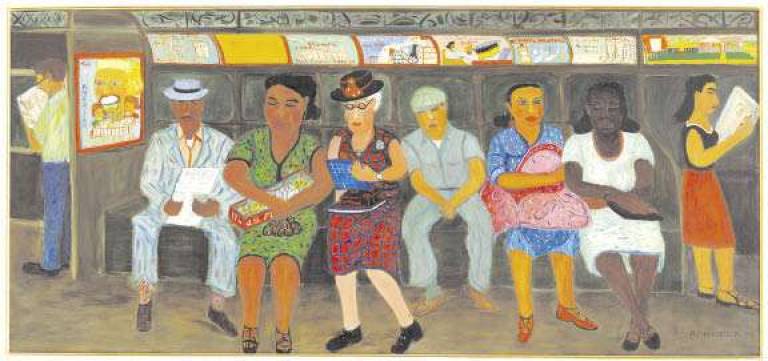Strokes of Genius at the American Folk Art Museum

A selection of works from the collection is now on view
Lincoln Square Walk through the modest gallery space housing this exhibit, Self-Taught Genius: Treasures from the American Folk Art Museum (through August 17, 2014), and you'll be surprised at the richness and variety of the works on display-and the sheer number, some 100 in all.
There are portrait paintings, landscape paintings, mourning paintings, needlework, quilts, pottery, sculpture, furniture, decoys, weather vanes, a carousel lion and a carnival banner. The show pays homage to the decorative arts, but also to fine art. Ammi Phillips' iconic Girl in Red Dress with Cat and Dog (c. 1830-35) opens the show, and Edward Hicks (The Peaceable Kingdom, 1829-31), Horace Pippin (Outpost Raid: Champagne Sector, 1931), and Grandma Moses (Dividing of the Ways, 1947) are represented.
Curiosities, and gems, abound. There's a precious miniature bed adorned with carved animals, an artful, tripod folding chair, a tin knife grinder, and a long, unidentifiable object wrapped in colored yarn and fabric by Judith Scott (1943-2005), a California woman who was deaf and had Down syndrome.
There's an eight-foot-tall model of the Empire State Building (c. 1931) meticulously crafted from tiny interlocking pieces of cherry wood (no glue, no nails), and a soaring model of a museum, Encyclopedic Palace (c. 1950s), that was to be located in Washington, D.C., and showcase human inventiveness-a paean to "all the works of man in whatever field?everything from the wheel to the satellite," according to creator Marino Auriti, an auto-body mechanic, whose out-sized architectural dream was never realized.
In short, there's something here for everyone. Pick your medium-and your passion. Quilt lovers will revel in the kaleidoscopic quilt by New Yorker Paula Nadelstern (Kaleidoscopic XVI: More Is More, 1996), or the one made by household slaves at a Kentucky plantation, not the mistress of the house (Whig Rose and Swag Border Quilt, c. 1850). Commuters may experience a sense of déjà vu upon seeing Subway Riders (1950), Ralph Fasanella's vivid lineup of passengers that is on loan from the Fifth Avenue/53rd Street subway station. The works span centuries, harking back to the 18th century and extending into the present century. In many cases the artists and craftsmen are unidentified; they are in all cases without formal training, fashioning art "in the trenches of life and not in the halls of the academy," curator Stacy C. Hollander writes in the catalog.
The show trumpets creativity, the capacity of each individual to dig deep inside and pull out something original-to find his or her "genius" and run with it. Hollander resurrects an 18th century debate about the origins of artistic and literary inspiration, noting "a deepening conviction that natural or original genius was truer than genius built on precedent that risked mere imitation."
Enlightenment theories notably represented a movement away from belief in "God-given" genius (divine intervention as the spark) to a rationalist belief in innate genius that could be cultivated and worked. Self-education was firmly embedded in the culture of the early American republic. Today however, the show's organizers maintain, the self-taught concept has evolved to the extent that it typically refers to "outsider" artists, those "working outside the art historical canon and often in isolated circumstances."
Co-curator Valérie Rousseau observes, moreover, that creativity in the artistic realm may be the by-product of adversity, writing: "For self-taught artists?[it] often arises at a turning point in their lives, at a moment when they need to reinvent themselves: separation, disease, loss of a loved one, an impending move, emigration, radical isolation, retirement?circumstances that lead to perceiving the world in a sharper and more sensitive way."
The works here are characterized by a simplicity and directness, perhaps none more so than the early portrait paintings or Asa Ames' wooden bust, Phrenological Head (c. 1850). A depiction of a young girl whose skull is colorfully sectioned to denote the different regions, or faculties, of the brain, she represents the popularity at the time of phrenology, the pseudoscientific practice of examining the bumps on the human skull, which were believed to be synced with specific mental and character traits and subject to alteration in the name of self-improvement.
Grace note: the exhibit boasts the museum's first gift, Flag Gate (artist unidentified, c.1876), a New York farm gate in the shape of the American flag, acquired in 1962 and believed to have been crafted in honor of the nation's centennial.